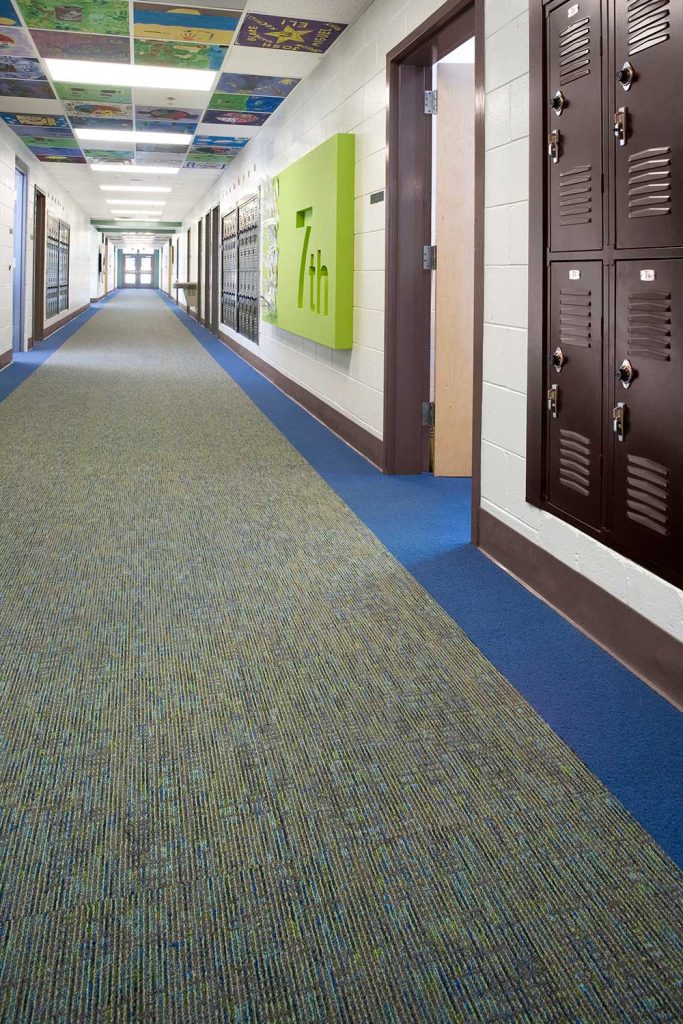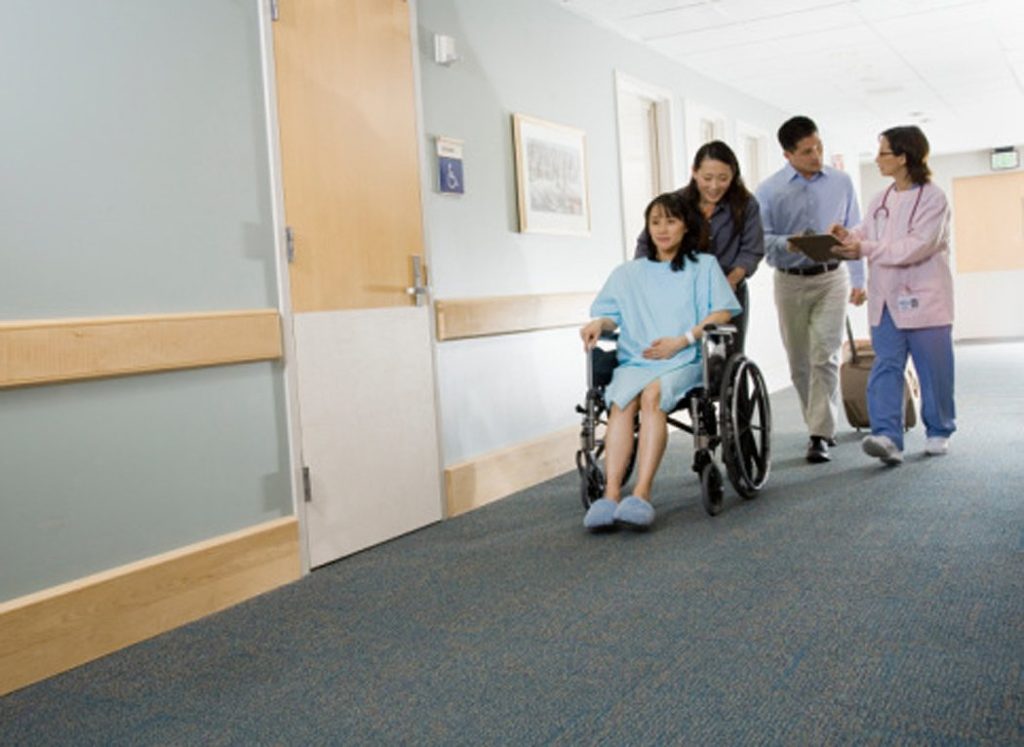
Carpet in Schools
School design has a strong impact on student learning and teacher satisfaction. Carpet contributes to good design by creating a welcoming, friendly, and warm space for students, teachers, and all school personnel.
Carpet’s benefits in schools as compared to hard flooring options include:
- Improved safety: Carpet’s traction helps prevent slips and falls. When falls do happen, chances of injury are greatly reduced on soft flooring.
- Increased comfort: For teachers and staff who stand throughout the day, a cushioned walking and standing surface reduces leg fatigue. Plus, carpet provides a non-glare surface that reduces reflection and eyestrain.
- Better insulation: Carpet’s warmth allows teachers to extend the learning area to space on the floor, especially with younger children. Thermal comfort exists because carpet retains inside ambient temperatures longer than does hard flooring.
- Costs less over time: Carpet that is properly selected, installed, and maintained lasts up to 10 years or longer. When schools consider product, installation and maintenance supplies, and labor costs over a 15- to 20-year period, carpet delivers lower life-cycle costs than other floor coverings.
Learn more: A Life-Cycle Cost Analysis for Floor Coverings in School Facilities - Reduced noise: Based on a study by the American Society of Interior Designers, carpet is 10 times more efficient in reducing noise compared with other flooring options. Additionally, school rooms that use carpet require less acoustic protection on the ceiling and elsewhere in the interior space. This quieter environment provides a better learning atmosphere with fewer distractions.
- Improved indoor air quality (IAQ): Carpet improves IAQ by capturing allergens in its fibers, thus preventing them from circulating back into the air. Regular vacumming removes the allergens. Additionally, carpet produces lower chemical emissions than most indoor furnishings.

Carpet in Schools
School design has a strong impact on student learning and teacher satisfaction. Carpet contributes to good design by creating a welcoming, friendly, and warm space for students, teachers, and all school personnel.
Carpet’s benefits in schools as compared to hard flooring options include:
- Improved safety: Carpet’s traction helps prevent slips and falls. When falls do happen, chances of injury are greatly reduced on soft flooring.
- Increased comfort: For teachers and staff who stand throughout the day, a cushioned walking and standing surface reduces leg fatigue. Plus, carpet provides a non-glare surface that reduces reflection and eyestrain.
- Better insulation: Carpet’s warmth allows teachers to extend the learning area to space on the floor, especially with younger children. Thermal comfort exists because carpet retains inside ambient temperatures longer than does hard flooring.
- Costs less over time: Carpet that is properly selected, installed, and maintained lasts up to 10 years or longer. When schools consider product, installation and maintenance supplies, and labor costs over a 15- to 20-year period, carpet delivers lower life-cycle costs than other floor coverings.
Learn more: A Life-Cycle Cost Analysis for Floor Coverings in School Facilities - Reduced noise: Based on a study by the American Society of Interior Designers, carpet is 10 times more efficient in reducing noise compared with other flooring options. Additionally, school rooms that use carpet require less acoustic protection on the ceiling and elsewhere in the interior space. This quieter environment provides a better learning atmosphere with fewer distractions.
- Improved indoor air quality (IAQ): Carpet improves IAQ by capturing allergens in its fibers, thus preventing them from circulating back into the air. Regular vacumming removes the allergens. Additionally, carpet produces lower chemical emissions than most indoor furnishings.
Healthcare and Eldercare Facilities

Selecting the Right Carpet
Color selection: Carpet offers a diverse array of color options that provide a variety of stimulating or soothing effects. Interestingly, color can play a significant role in facilities or units that care for patients with Alzheimer’s disease. According to the Alzheimer’s Association, patients seem to remember colors better than numbers; therefore, color in carpet can provide a link to a specific hall or wing. In areas with visually impaired patients, brighter colors aid in depth perception and differentiation of areas.
Americans with Disabilities Act: The Americans with Disabilities Act requires carpet to have a pile height of a half-inch or less, as measured from the bottom of the tuft.
Carpet construction: The look of a carpet is determined by its construction, which may be level loop, multi-level loop, cut pile, or combinations of cut and loop pile. In corridors, lobbies and patient care areas, loop piles tend to retain their appearance and resiliency. Loop piles generally provide a better surface for rolling traffic, especially when the carpet has a low, dense construction. Cut pile or cut and loop pile carpet are both good choices for administrative areas.
Performance: In the healthcare market, carpet performance needs determine the fibers, construction, backing systems, and treatments should be used. he specifier must delineate the highest priority performance requirements so that the manufacturer’s representative can recommend products that meet those expectations.
Fiber: Nylon, olefin (polypropylene), triexta, and wool are the primary fibers used in commercial carpet for healthcare applications. Nylon accounts for approximately 80 percent of the overall commercial carpet market. It delivers excellence in wearability and abrasion resistance, is easily cleaned, and can be stain resistant. Olefin is used where resistance to sunlight fading and chemicals is more important than durability. Triexta is a new fiber category developed by DuPont. Wool is a natural staple fiber, is durable, resilient, and self-extinguishing when burned.
Yarns: Bulk continuous filament (BCF) or staple. Staple yarns are short fibers that may fuzz or lose fiber more than BCF; therefore, BCF is chosen more often for healthcare use.
Dyeing: The method by which carpet is dyed is important for patient care areas. Solution dyeing is preferred in areas subject to stains and spills because the color is achieved by the pigment within the yarn. Other areas in healthcare facilities, such as offices, lobbies, and corridors may employ a variety of dye methods, such as stock dyeing, yarn dyeing, piece dyeing, and printing, all of which are dependent on the amount of pattern and colors needed for the interior appearance.
Static electricity considerations: Carpet can be specified to meet criteria for the static electricity tolerances of highly sensitive electronic areas, such as computer rooms or telemetry units.
Microbiological considerations: Antimicrobial treatments considered helpful in reducing the propagation and spread of microorganisms have been used in healthcare carpet since 1980. Antimicrobial treatment benefits a healthcare facility by providing insurance for when spots and spills cannot be immediately cleaned; however, it does not eliminate the need for a regular cleaning and maintenance plan.


